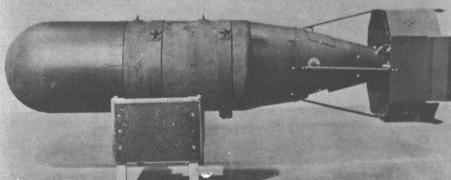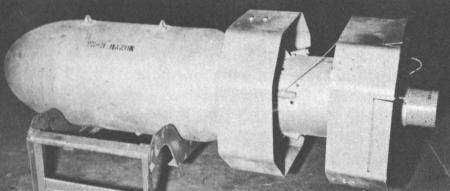VB Series
(VB-1 through VB-13) (original) (raw)
The VB designation was introduced by the U.S. Army Air Force in 1943, and covered unpowered guided bombs with effectively no standoff gliding range (i.e. "vertical" bombs).
ATSC VB-1/VB-2 Azon
In April 1942, the USAAF's Materiel Command (became part of ATSC (Air Technical Service Command) in 1944) began the development of the Azon family of guided bombs. The initial variant, designated VB-1, was based on a 450 kg (1000 lb) bomb (initially the M44, but later models apparently switched to the standard AN-M65), which was modified with a new tail unit. The latter consisted of a gyroscopic unit to provent the bomb from rolling, a flare for optical tracking, an octagonal shroud with control surfaces, and a radio-command receiver. When a VB-1 was dropped, the bombardier could track it through his bombsight and use a joystick-type control to send corrective commands to the bomb. The Azon guidance system allowed only lateral course corrections, but errors in range could not be corrected (hence the name Azon = "Azimuth Only").
The Azon development phase ended in late 1943, and the VB-1 was subsequently ordered into mass production. The second _Azon_variant was the heavier VB-2, which was based on a 900 kg (2000 lb) bomb, but that version was apparently not produced in very large numbers. The first VB-1/2 bombs were sent to Europe in February 1944, and a total of 15000 Azons were produced until November 1944.
 |
|---|
| Photo: via Ordway/Wakeford |
| VB-1 |
Because of their azimuth-only guidance, the VB-1 was particularly suited to long and narrow targets (like bridges or railways) where range errors would be irrelevant. For "normal" targets, however, the VB-1 was actually not as good as unguided free-fall bombs, because a bomber could not break away immediately after dropping the bomb, and the accuracy was effectively not increased because of the lack of range control. Another peculiarity of the Azon guidance set was the fact that only five different radio channels were available for the command link, meaning that not more than five bombs could be controlled independently. Although in theory a whole group of bombs using the same command channel could be controlled simultaneously, this was not practical. The accuracy of all but the "primary" bomb (i.e. the one which was tracked by the bombardier) in such a group was rather bad, because the non-spinning_Azon_ bombs showed a significant dispersion.
The drawbacks of the Azon meant that its use remained very limited. However, it was employed rather successfully in Burma, where it was used to destroy very vital and therefore heavily defended bridges along the Japanese supply lines. Less the 500 _Azons_were needed to destroy 27 bridges.
When the war ended, the USAAF quickly removed the VB-1 and VB-2 from its inventory. Because of the much reduced post-war funding, the USAAF limited its guided vertical bomb research to the more advanced VB-3/VB-4 Razon family.
ATSC VB-3/VB-4 Razon
In parallel with the Azon tests, the ATSC also developed a more advanced variant called Razon, which was to be controllable in both range and azimuth. The designations VB-3 and VB-4 were assigned to the 450 kg (1000 lb) and 900 kg (2000 lb) Razon versions, respectively. The Razon guidance kit had two octagonal shrouds in a tandem arrangement. The most problematic part in Razon development was to build a suitably modified bombsight, which would allow the bombardier to correctly judge the bomb's deviation in range so that the range control could be used effectively. The Razon also had an improved radio-command link with 47 separate channels, effectively eliminating the Azon's problems with concurrent drops by a multitude of bombers.
 |
|---|
| Photo: via Ordway/Wakeford |
| VB-3 |
The VB-3/VB-4 was combat-ready in summer 1945, and about 3000 Razons were subsequently produced, but none of them were used before World War II was over. However, the VB-3 was operationally tested five years later during the first months of the Korean War. B-29 aircraft, which could carry eight VB-3s, dropped several hundred Razons on North Korean bridges, and although the overall reliability of the bombs was rather low, some targets were actually destroyed. However, in general multiple hits by the small the 450 kg (1000 lb) bombs were needed to destroy a large bridge span, and the USAF's use of guided bombs for these special missions switched to the much larger VB-13/ASM-A-1 Tarzon.
ATSC VB-5
The VB-5 was a 450 kg (1000 lb) bomb, which used the same tandem octagonal control shroud arrangement as the VB-3/VB-4_Razon_. However, the VB-5 was not command guided but used an autonomous light contrast seeker. This bomb did not go into production, presumably because the guidance mechanism didn't work as planned.
ATSC VB-6 Felix
The VB-6 Felix was a 450 kg (1000 lb) bomb with an octagonal control shroud and a heat seeking device in the nose. Intended for use against strong infrared emitters (like e.g. blast furnaces), the VB-6 was tested with some success during 1945, but the program was cancelled at the end of World War II. The U.S. Navy developed a very similar IR-guided bomb as theASM-N-4 Dove.
ATSC VB-7, VB-8
The VB-7 and VB-8 both used a TV/radio-command guidance, where a TV camera in the bomb's nose transmitted the image to a display set for the bombardier, who could then correct the bomb's course by radio-commands. The weights of the VB-7/VB-8 are unclear, but it can be assumed that these two guided bombs were cancelled early in the development phase.
Douglas VB-9/VB-10/VB-11/VB-12 Roc
The Roc series of guided bombs was developed by Douglas, the MIT and the NDRC (National Defense Research Committee). The VB-9 model was a 450 kg (1000 lb) bomb with cruciform wings and fins and a radar seeker in the nose. The radar image was transmitted to the bombardier who could use it to direct the bomb's path by radio commands. However, the radar was often useless because of ground clutter, and the VB-9 program was terminated in early 1945.
The VB-10 (and presumably also the VB-11/VB-12 models) was tested between September 1944 and May 1945, when the _Roc_program was terminated without any model going into production.
Bell VB-13 Tarzon
The VB-13 is discussed on a separate page about the VB-13/ASM-A-1 Tarzon.
Specifications
The few available data on the dimensions and weights of the VB-series bombs are mentioned in the main text.
Main Sources
[1] Frederick I. Ordway III, Ronald C. Wakeford: "International Missile and Spacecraft Guide", McGraw-Hill, 1960
[2] Bill Gunston: "The Illustrated Encyclopedia of Rockets and Missiles", Salamander Books Ltd, 1979
[3] USAF Museum Website
[4] David R. Metz: "The Quest for a Surgical Strike: The Air Force and Laser-guided Bombs", 1987
Back to Directory of U.S. Military Rockets and Missiles, Appendix 1
Last Updated: 9 February 2003